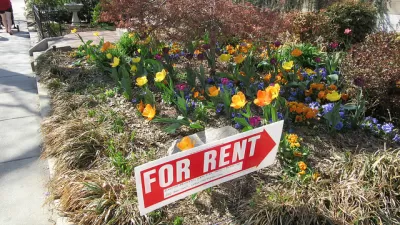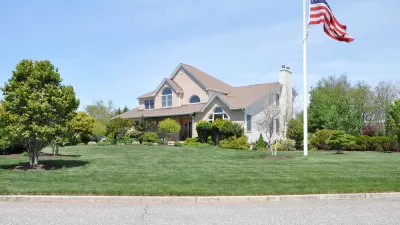Numerous popular and academic writers from the 1950s and 1960s critiqued suburban development patterns and found them wanting.
Amanda Kolson Hurley writes in Curbed about the popular and academic literature from the 1950s and 1960s on the topic of "suburban anomie." Apparently the good old days weren't quite so good after all.
Hurley explains
In the years after World War II, suburbs represented not just new places to live but a whole new manner of living, separated by more than physical distance from the big cities and small towns from which their residents hailed. Between the late 1940s and 1960, millions of Americans moved into raw neighborhoods containing people of about the same age, making about the same amount of money, starting families at about the same time. It was a social experiment unprecedented in U.S. history. The first suburbanites themselves were well aware of this. Although they felt the optimism of pioneers, they shared in the widespread anxiety that the experiment might not work, an anxiety that manifested as worries about unanticipated health effects. These ranged from the daily, cumulative frustrations of a Mary Drone to more significant problems: stomach ulcers, heart attacks, anxiety, depression, sexual dysfunction, and juvenile delinquency.
FULL STORY: Welcome to Disturbia

Planetizen Federal Action Tracker
A weekly monitor of how Trump’s orders and actions are impacting planners and planning in America.

Vehicle-related Deaths Drop 29% in Richmond, VA
The seventh year of the city's Vision Zero strategy also cut the number of people killed in alcohol-related crashes by half.

Map: Where Senate Republicans Want to Sell Your Public Lands
For public land advocates, the Senate Republicans’ proposal to sell millions of acres of public land in the West is “the biggest fight of their careers.”

Berlin to Consider Car-Free Zone Larger Than Manhattan
The area bound by the 22-mile Ringbahn would still allow 12 uses of a private automobile per year per person, and several other exemptions.

The Ratio of Older People to Children Grew in Every State
Older adults outnumber youth in 11 U.S. states.

LA Transit Ridership Plummets Amidst ICE Raids
LA Metro’s bus and rail lines are seeing up to 15 percent lower ridership in the wake of violent immigration arrests.
Urban Design for Planners 1: Software Tools
This six-course series explores essential urban design concepts using open source software and equips planners with the tools they need to participate fully in the urban design process.
Planning for Universal Design
Learn the tools for implementing Universal Design in planning regulations.
Heyer Gruel & Associates PA
JM Goldson LLC
Custer County Colorado
City of Camden Redevelopment Agency
City of Astoria
Transportation Research & Education Center (TREC) at Portland State University
Camden Redevelopment Agency
City of Claremont
Municipality of Princeton (NJ)





























